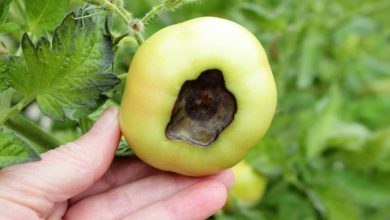Blue Flowers: [10 Examples, Care, Characteristics]
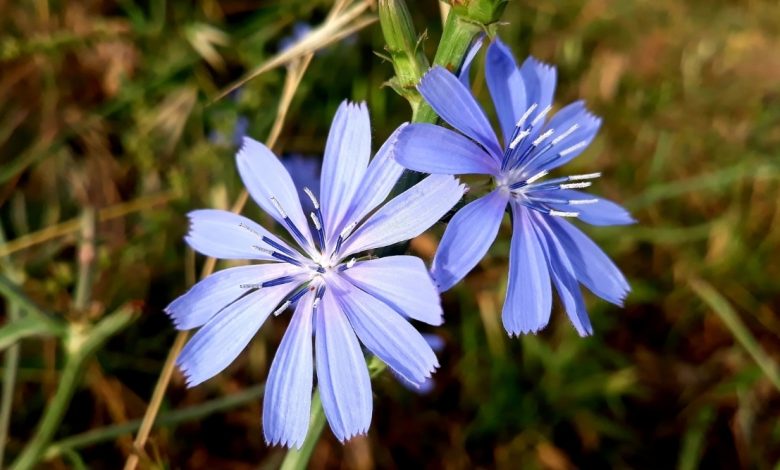
Blue flowers are a large group that are responsible for providing an air of confidence, mystery and elegance in the place where they are.
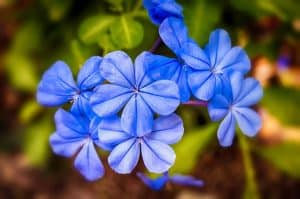 They can be used to make internal arrangements in the home or as a contribution to the external composition, in the garden.
They can be used to make internal arrangements in the home or as a contribution to the external composition, in the garden.
They are flowers that generate an incredible contrast with the green of the leaves of their base plants, although it is a cold and generally dark color. Do you want to meet some guys?
water lilies
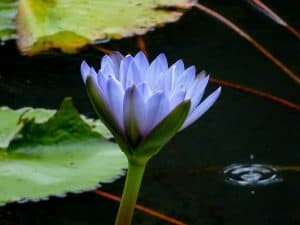 Water lilies are blue, wild flowers that grow profusely on the spike to which they cling and are also of a good size.
Water lilies are blue, wild flowers that grow profusely on the spike to which they cling and are also of a good size.
The greatest contrast is made with its internal part that is made up of yellow hairs, thus standing out on the structure of the petals.
To thrive, they need to be in a humid environment, so it is common to find them near lakes during spring and summer.
In Spain it is very widespread because it has managed to adapt very well to the climatic conditions that are generated throughout the year.
hydrangeas
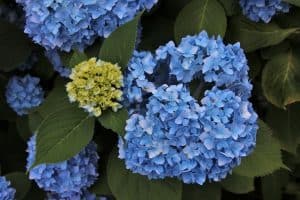 The hydrangea is one of the best known and most striking speciesfor its light blue flowers whose central point stands out in a beautiful pale yellow.
The hydrangea is one of the best known and most striking speciesfor its light blue flowers whose central point stands out in a beautiful pale yellow.
The main characteristic for them to look beautiful is that they do not tolerate direct exposure to the sun or excessive heat. To man the freshness.
The flowers grow very close together, making it appear that it is a series of bouquets. An interesting fact is that different shades of blue can be obtained depending on the level of acidity of the soil where they are planted.
bellflowers
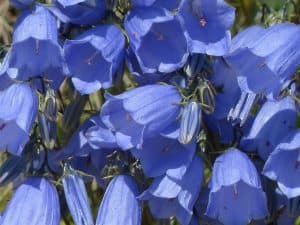 Campanulas stand out for having a shape that resembles small bells that hang from clusters that rise.
Campanulas stand out for having a shape that resembles small bells that hang from clusters that rise.
These occupy the entire length of the stem, unlike other species that are usually located only at the top of the branch.
Inside they have small antennas that give it a more striking effect although, in general, they are quite attractive in themselves.
For those who love fresh cooking, Campanula will also add a kick in this regard because its roots and leaves can be eaten.
Muscaris
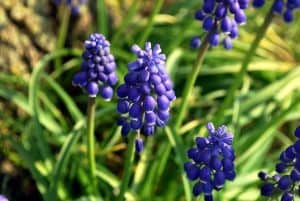 How many times have our eyes been delighted with bulbous-looking flowers like those produced by muscaris?
How many times have our eyes been delighted with bulbous-looking flowers like those produced by muscaris?
It is a very characteristic blue flower that can also have white or violet details throughout its structure.
Its growth is done around the top of a stem that rises from the base of the plant and supports the flowers that are born around it. It is a species that adapts well to almost any climate, so it is common to see them in gardens throughout Spain.
chinese bells
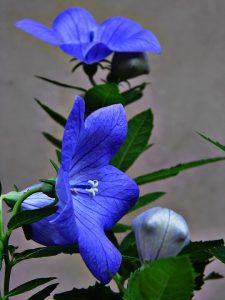 When you want to have blue flowers of good size and that grow independently, Chinese bells are a good option.
When you want to have blue flowers of good size and that grow independently, Chinese bells are a good option.
The color is dark blue, perhaps similar to violet in some cases, but you can also find varieties in pink, lilac and even white.
They do not need much care, but they are quite productive in the amount of flowers they generate, which makes them ideal for ornamental purposes.
Lobelia
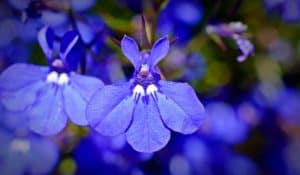 It has a structure more similar to the types of flowers we know, with petals that unfold around a single pistil.
It has a structure more similar to the types of flowers we know, with petals that unfold around a single pistil.
The size is variable, as there are small or dwarf versions and larger ones, making it a good alternative for compositions.
cornflowers
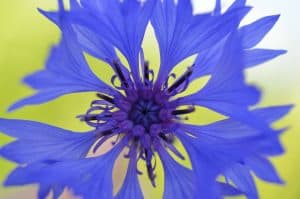 Cornflowers are annual plants that can beautify your garden not only with their own beauty but with the fact that they are known to attract butterflies and bees.
Cornflowers are annual plants that can beautify your garden not only with their own beauty but with the fact that they are known to attract butterflies and bees.
They usually have around ten petals on each stem. These flowers need a completely sunny spot to bloom continuously and well-drained soil for good root development. They are not suitable for growing indoors.
In the past, this flower was known as «Bachelor’s Button Flower» because bachelors wore it to show their feelings for the girls they loved. This is also the national flower of Poland.
delphinium
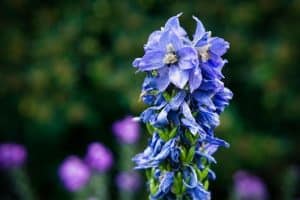 Delphinium flowers are generally a symbol of strong attachment, perhaps due to the fact that they are tall and need a wall or something else to attach to in order to grow strong and beautiful.
Delphinium flowers are generally a symbol of strong attachment, perhaps due to the fact that they are tall and need a wall or something else to attach to in order to grow strong and beautiful.
This also gives you the opportunity to use them as part of your paradise garden as cut flowers for indoor vase floral designs. They also need well-drained soil and full sunlight for at least half the day in order to flower continuously.
However, despite their preference for sunny places, delphiniums are not friends with very hot weather conditions and prefer summer seasons that are less dry and with not so high temperatures.
They also do not grow well in rainy and/or windy places.
Clematis
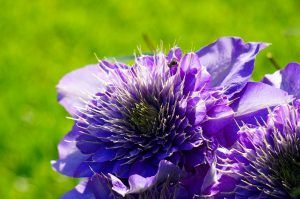 Clematis is a climbing plant that is a very good option for decorating fences, walls and different ornaments in your garden.
Clematis is a climbing plant that is a very good option for decorating fences, walls and different ornaments in your garden.
It comes in different colors, but the blue version is associated with courage and fidelity.
It prefers well-drained soil and flowers continuously if exposed to direct sunlight throughout the day.
If you want to achieve a gorgeous result and have a stunning flower covered adornment, you can pair different colors of clematis with different colors of climbing roses, it will definitely be inspiring and gorgeous!
germanic iris
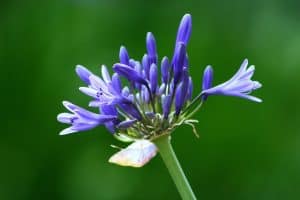 The Germanic Iris or Blue Lily is a highly resistant herbaceous plant that belongs to the Iridaceae family.
The Germanic Iris or Blue Lily is a highly resistant herbaceous plant that belongs to the Iridaceae family.
It is a typical species of central Europe. It is also known by the names of common lily, purple lily, purple lily, blue lily or Easter lily.
When do we grow it? It should be done in late spring and early fall.
It does not demand a very special land. Make do with fertile, well-drained, pH – neutral soils.
We can also consider it as an ornamental plant.
Blue flower care
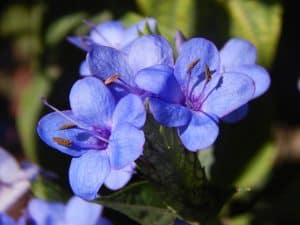 Most plants that produce blue flowers are moisture-loving in the ground, so wild versions grow near lakes and rivers.
Most plants that produce blue flowers are moisture-loving in the ground, so wild versions grow near lakes and rivers.
At home, the issue of irrigation should be assessed according to each species, taking care not to flood. For this, it is advisable to use spraying or dripping and, preferably, on the basis of the plant.
When the soil is well nourished, fertilization is not much needed, unless the plant requires it in order to flourish abundantly. Pruning will also be an important issue to ensure that the plant is full of health. In that sense, it can generate blue flowers with a better presence and in greater quantity.
As in most cases, the pruning will be done during rest times and, the best thing is that it is only applied to remove damaged parts of the plant.
Characteristics of this type of flowers
Blue flowers have a series of characteristics that are very specific to their hue, which we mention below:
- In many cases, its lighter or darker color is given depending on the level of acidity of the soil.
- They tend to prefer shaded areas, although there are species that grow well in open fields but with good humidity.
- In general, they are flowers that are born during the spring and summer seasons and fall at the beginning of autumn. However, there are versions that still remain on the plant throughout the fall.
- They work best in temperatures that are not too cold or too hot, especially they like cool climates.
- They are not usually very resistant to gusts of wind, so they must be kept protected in places where they can be put at risk.
Meaning of blue flowers
Blue flowers can be associated with a series of specific meanings depending on the type of objective for which they are to be used, for example:
Love
They are used in sentimental relationships that are already established, ideal for celebrating anniversaries, for example. Around this theme, they transmit well-being and confidence.
Status
Blue flowers are often seen with an air of elegance and comfort. Its use as an interior decoration mechanism generates a sophisticated climate.
Emotions
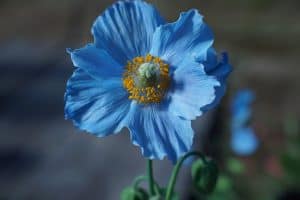 To work on emotions, blue flowers are good allies because they help inspire a climate full of peace and tranquility.
To work on emotions, blue flowers are good allies because they help inspire a climate full of peace and tranquility.
Blue flowers can be used as a complementary part of a composition with other colors or left as the only protagonists.
In any case, the effect obtained will always be more or less similar: serenity and balance.
Bibliography and references
- Raven, Peter H.; Evert, Ray Franklin; Eichhorn, Susan E. (1992). Plant biology. Editorial Reverté. Barcelona, Spain.
- Edward Bent, Aldo Colombo. (2018). The hydrangeas. Cultivation and care. Parkstone International. New York, USA.
- Giardino, Monica. (2011). The blue rose. Elements for a phenomenology of flowers in globalized societies. Phenomenological Research Magazine. Buenos Aires’ University. Buenos Aires, Argentina. Reproduced from: https://dialnet.unirioja.es/descarga/articulo/4846531.pdf
- Sanudo-Torres, Rosario Raudel; Vazquez-Peñate, Pascual; Armenta-Lopez, Celso; Azpiroz Rivero, Hilda Susana; Campos Beltran, Cecilia; Ibarra-Ceceña, Maria Guadalupe; Felix-Herran, Jaime Alberto. (2009). Pregerminative treatments in ironwood seeds (Olneya tesota A. Gray) and propagation in water lily compost substrate (Eichhornia crassipes). Ra Ximhai Magazine. Autonomous Indigenous University of Mexico. El Fuerte, Mexico. Reproduced from: http://www.redalyc.org/articulo.oa?id=46111817007

![Photo of The Diamond Yam: How, Where and When to Plant it? [Steps + Images]](https://www.complete-gardening.com/wp-content/uploads/2022/08/the-diamond-yam-how-where-and-when-to-plant-it-steps-images-390x220.jpg)
![Photo of How to Plant Tulips and Have a Spectacular Garden: [12 Steps + Images]](https://www.complete-gardening.com/wp-content/uploads/2022/08/how-to-plant-tulips-and-have-a-spectacular-garden-12-steps-images-390x220.jpg)

